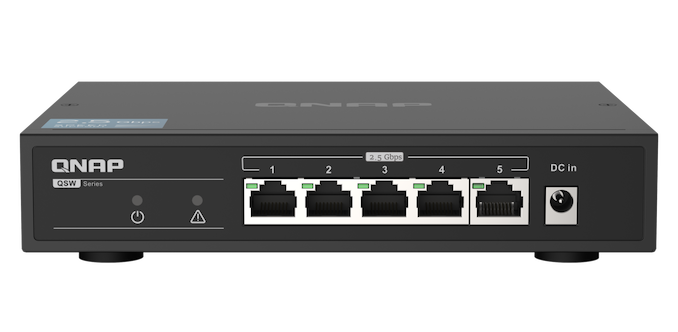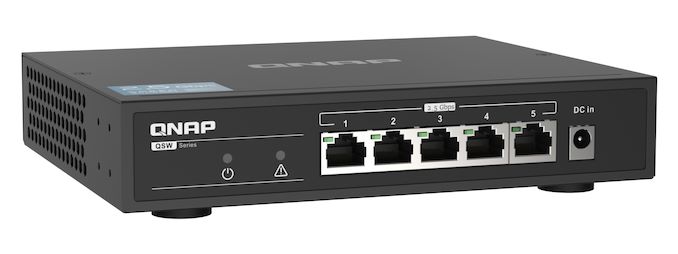At Last, a 2.5Gbps Consumer Network Switch: QNAP Releases QSW-1105-5T 5-Port Switch
by Ryan Smith on July 17, 2020 11:30 AM EST- Posted in
- Networking
- QNAP
- NBASE-T
- 2.5GBase-T
- Ethernet
- 2.5 GbE

After entirely too long of a delay, the wait for faster consumer-grade network switches appears to be coming to an end. This week QNAP launched its QSW-1105-5T switch, one of the industry’s first unmanaged 2.5Gbps (2.5GBASE-T) switches. The 5-port switch supports 2.5GbE operation on all five of its RJ45 Ethernet ports, and along with being unmanaged it is also fanless, allowing the switch to work maintenance-free and installed virtually anywhere. The QSW-1105-5T is already on sale in Taiwan for roughly $100, meaning that we’re looking at a price-per-port of about $20.
The saga of NBASE-T has been something of a long one. First introduced in 2016, the standard added the then-new 2.5GBASE-T and 5GBASE-T modes, which were designed to offer a series of intermediate steps between the existing 1Gbps (1000BASE-T) and 10Gbps (10GBASE-T) standards. By scaling down parts of the 10GBASE-T spec, the new standards would allow more modest – but still many times faster – network transmission rates than 1Gbps Ethernet, all the while being able to reuse existing Cat5e and Cat6 cabling. Overall, 2.5GBASE-T allows for 2.5Gbps Ethernet over Cat5e at the same 100m distances as 1Gbps Ethernet, while 5GBASE-T allows for 5Gbps speeds over 100m runs of Cat6, as well as quasi-official support for shorter Cat5e runs.
Given the technology reuse, moderately-priced NBASE-T network cards were quick to hit the market. However affordable switches have been a more complex matter: while the high initial price of NBASE-T was easy enough to eat on a single controller, multiplied over several ports on a switch, it quickly drove up the price tag. As a result, the market for NBASE-T switches has largely between split between downgraded pro gear like Netgear’s $70-per-port XS505M, and mixed-port switches like Asus’s XG-U2008, which offer just two 10G/NBASE-T ports along with a slew of Gigabit Ethernet ports. So cheap NBASE-T networking options have remained elusive, at least until now.
Thankfully, in the last year we’ve finally started seeing the slower of the NBASE-T modes, 2.5GBASE-T, sprint towards wide adoption. The 2.5Gbps standard is the cheapest to implement, and with recent controller releases from the likes of RealTek and Intel, 2.5Gbps controllers have quickly become a staple on high-end motherboards. Accordingly, with the price per port coming down for 2.5Gbps controllers, it’s also bringing down the price of whole switches. And this is where QNAP’s new switch comes in.
The QSW-1105-5T is one of the first switches to be released using these new generations of cheap controllers. Aimed squarely at the home and SMB markets, the switch doesn’t offer any frills such as network management, Power over Ethernet, or SFP+ ports. Instead it focuses on the things that matter for the home market: supporting 2.5Gbps networking in a small, passively-cooled switch that’s suitable to be neglected by being tucked under a desk or in a closet.
| QNAP QSW-1105-5T Switch | |
| Speeds | 100M/1G/2.5G |
| Ports (RJ45) | 5 |
| Managed | No |
| Power | 12 W |
| Dimensions | 3.4 x 18 x 14.5 cm |
| Cooling | Passive (Fanless) |
| Price | ~$100 |
As the first of what will undoubtedly be many 2.5G switches over the coming months, the QSW-1105-5T also gives us our first real look at what we can expect from this generation of switches as far as footprints and power consumption goes. Since it’s not carved from a pro-grade switch, the 18 cm x 14.5 cm switch is significantly smaller than earlier NBASE-T switches. And with a maximum power consumption rating of 12 W, we’re looking at power consumption of just a bit over 2 Watts per port, which is also a significant improvement over admittedly far more powerful switches.
All of which sounds unremarkable, and indeed that’s exactly what makes the QSW-1105-5T so interesting. The biggest barrier to wide consumer adoption over the last few years has been the cost – both in regards to the core technology and added frills – so we’ve been waiting for quite a while to see NBASE-T technology transition from pro-grade switches to cheap, consumer-grade gear.
Otherwise, QNAP’s new switch is further evidence that the PC industry is going to coalesce around 2.5Gbps Ethernet for the time being. Besides being the fastest standard to officially and fully support Cat5e cabling – which was installed in walls en masse when home networking first took off – it’s also the cheapest and lowest-power option. This is allowing it to be widely deployed not only in new motherboards and cheap USB adapters, but finally in switches as well – and making QNAP’s new switch a good match for all of those new NICs. And while I’d like to see cheaper 5Gbps and 10Gbps gear as well, 5GBASE-T seems likely to remain a premium (if not niche) option, owing to the higher controller costs as well as its higher power consumption, both of which remain big problems for a switch.
At any rate, QNAP’s 2.5Gbps switch is on sale now in Taiwan. The company has not announced release dates elsewhere, but judging from some of their previous product releases, I’d expect it to start showing up in North America some time in the next few months.
Source: QNAP

















98 Comments
View All Comments
HardwareDufus - Tuesday, July 21, 2020 - link
i'm not sure what you are doing internally in your home that requires 10GB.... and I don't want to know...close - Thursday, July 23, 2020 - link
@Gigaplex, sure there are things that happen on home networks that don't require the internet. Just that 99.9999% of them don't need 10G either. If they do then you already have it ;). If you're here complaining that you need 10G but don't have it then you don't *need* it, you *want* it for cheap bragging rights. Most people use WiFi for almost everything anyway. For a NAS and a main workstation a 100E (give or take) eBay switch with 2x10GB ports is already overkill for almost everyone. That's the thing, nobody cares about or wants to pay to subsidize YOUR needs.You don't have 30" water pipes in your house just because of that 1 guy who wants it cheap to empty the pool really fast. Or a 100 A, 480 V electrical wiring because 1 guy needs his high power welder.
@HardwareDufus, the answer is bragging. But somehow a type of sad bragging that admits they can't afford to buy a 10G switch today even if the used market has some for ~100E.
senttoschool - Saturday, July 18, 2020 - link
So what work tasks do “normal” people do at home that require a 10gbps network gear?Please don’t tell me they have to setup home servers. Those aren’t “normal” people.
And again, those who need it can afford 10gbps.
rahvin - Sunday, July 19, 2020 - link
Do you know how many times I've heard similar statements about technology in the 25+ years I've been building and using computers? I heard exactly those same things about 10Base-T back when 100M was the expensive upcoming standard.Why not argue normal people don't need wired network at all? Or that we don't need wifi at all now that LTE exists. Your argument is old and tired.
PeachNCream - Monday, July 20, 2020 - link
Do you know how many times those statements were correct in the context of the present day? Most, if not all of them were correct at the time. While there is nothing at all wrong with pushing advancement along in terms of bandwidth in anticipation of greater future demand, the point people are making that you are attempting to refute is that present day home networks (mainly running WiFi anyhow since the vast majority of people buy computers that don't even have a wired ethernet port these days) would not benefit at the moment from increased wire speed. No one is arguing that in the future, there won't be a need. They are saying that currently households will not see a significant benefit.FreckledTrout - Wednesday, July 22, 2020 - link
The other side of that coin is that if technology lags to far behind it really sucks like many people here talking about there slow internet. I personally would rather see technology you don't need today ready to go for when the day comes for the average person to need it.Beaver M. - Monday, July 20, 2020 - link
Oh please... Home servers are very common.10 Gb would be overkill I guess. But 5 Gb would be nice. 2.5 Gb is simply stupid. Reminds me of SATA, which is dying right now because they couldnt get out a fast enough standard in time.
PeachNCream - Monday, July 20, 2020 - link
Servers in what sense? Pretty much everyone with a router has a DHCP server issuing out IP addresses to internal devices so those are common, but dedicated server hardware that hosts say network file storage or acts as a media/entertainment server is an obscure oddity that the vast majority of households even in first world countries to not operate. We technical sorts do that on occasion, but we are a small portion of the first world population (plus a lot of us in the tech industry don't bother with doing that sort of thing at home which cuts down the appeal to only a portion of information technology workers).Beaver M. - Tuesday, July 21, 2020 - link
Home server is home server. What are you talking about DHCP servers? Stay on topic!It doesnt matter if NAS or a self built server or even a rack. Home server is home server. Lots of people use one to store their media. Music, videos, photos. Simple as that. Everyone I know has one, even those who are not very tech-savy. Weird, huh?
Not really, because its very easy to install one.
PeachNCream - Tuesday, July 21, 2020 - link
"Home server is home server." " Everyone I know has one..."Odd how people resort to nonsense and embellishments over such an unimportant topic in order to defend an already shaky argument made up to support a needlessly aggressive opinion. You would have been better served (pun very much intended) in not responding rather than trying to respond with transparent falsehoods.